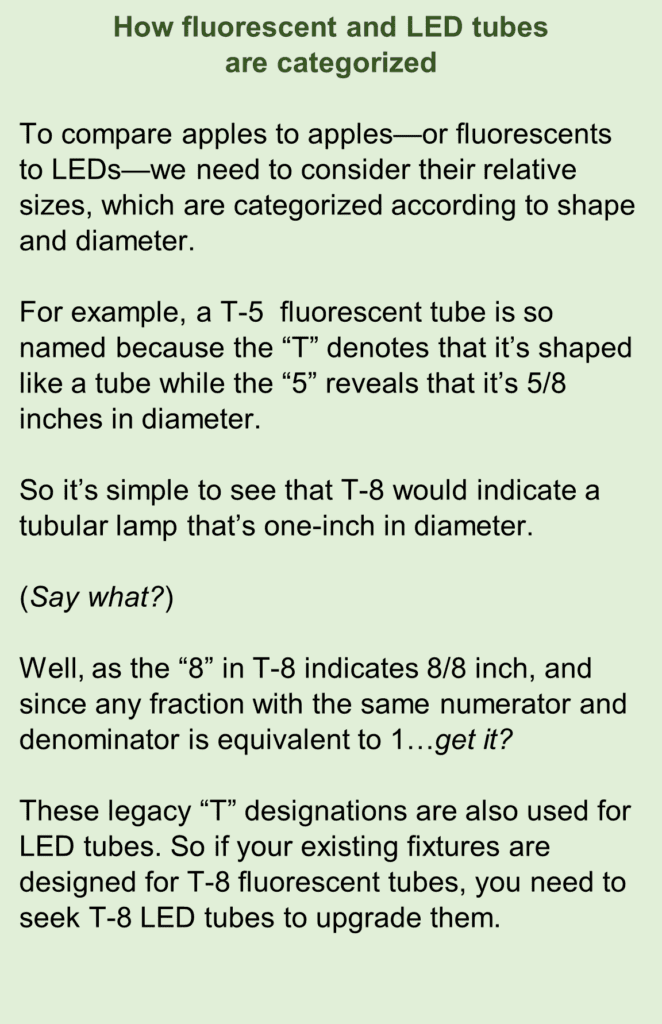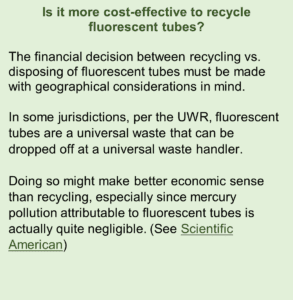Hazardous Waste Disposal Liabilities of LED Tube Upgrade
August 10, 2021
The economic case for converting from fluorescent to LED tubes is compelling. Consider:
- LEDs last longer than fluorescent tubes—and by no small sum. Wherein new LEDs can last roughly six-to-11 years in service, the typical fluorescent tube is ready for the trash bin between .80 and 1.9 year—except you can’t put them in the trash bin.
- LEDs are directional. This means they emit all their light downward within 180 degrees. This minimizes energy loss from the need to reflect light. In contrast, fluorescent tubes are omnidirectional. They emit light over 360 degrees, so fully one-half of the illumination needs to be reflected downward from the fixture, requiring it to be more complicated & expensive, which effectively squanders light & energy.
Okay, we can anticipate your question: Is the initial cost differential upfront worth the potential savings yonder down the road?
Short answer: absolutely. The long answer follows. Read on.
Price comparison between LED vs fluorescent tubes
Checking on major purveyors of fluorescent and LED tubes, we find (for example) that a single carton of 48-inch T-8 fluorescent tubes will set you back $4.85 PPP here, while a single carton of 48-inch T-8 LED tubes will cost you $7.50 PPP at the same place. (Buying multiple cartons, of course, reduces the PPP.)
That’s a difference of $2.65 or about 55 percent upfront. Thinking straight-line for a moment:
As the LED life expectancy is 6-to-11 years, the median is nine years. And as the fluorescent life expectancy is between .80 and 1.9 year, the median is a little north of 1.35 year. Thus it’s reasonable to say that the LED will last about 6.7 times longer than the fluorescent (9.0 ÷1.35 ? 6.7).
That means if you spent $4.85 PPP for fluorescent tubes and divide the cost across their median lifespan of 1.35 year, you’d be spending about $6.50 per fixture/year. In contrast, if you were to buy the same amount of LED tubes at $7.50 PPP and divide the cost across their median lifespan of nine years, you’d be spending 83 cents per fixture/year.
Okay, we promise no more math. But when you consider that 83 cents PPP is 783+ percent less yearly than $6.50 PPP, it’s pretty clear that the 55 percent upfront differential between LEDs and fluorescents is an investment—not a cost.
Fluorescent tubes require hazardous waste disposal
Obviously, the energy, capital, and maintenance-cost advantages of LED tubes over fluorescents are manifest. The light’s a lot nicer, too. But if you completely convert to LEDs in one fell swoop, then you’ll need a hazardous waste management plan for discarding or recycling what can likely be beaucoup amounts of retired tubes. This is why:
 Fluorescent lamps produce light by ionizing mercury vapor in a glass tube. This induces ultraviolet light that becomes visible when it contacts a phosphor coating on the tube’s inside, thereby rendering that horribly bright & harsh fluorescent hue that turns potatoes green (as well as some complexions).
Fluorescent lamps produce light by ionizing mercury vapor in a glass tube. This induces ultraviolet light that becomes visible when it contacts a phosphor coating on the tube’s inside, thereby rendering that horribly bright & harsh fluorescent hue that turns potatoes green (as well as some complexions).
The environmental problem this poses has to do mainly with mercury, which while moderately toxic in liquid form, becomes extremely noxious in its gaseous state, as it’s easily respired by the human body, entering the bloodstream to contaminate any number of vital organs that you’ve come to depend on over the years.
Such toxicity has engendered ever-increasing levels of legislation and regulation at federal, state, and local levels. Among them are stricter product-labeling requirements; sale prohibitions on certain products containing mercury; and in many jurisdictions, outright bans on mercury disposal, along with mandates for mercury recycling.
As we’re wont to advise: it’s essential to get expert advice.
EPA requirements for fluorescent tube hazardous waste disposal & recycling
Spent tubes containing mercury are regulated as hazardous waste by the EPA; and the Resource Conservation and Recovery Act (RCRA) stipulates that any entity that generates a hazardous waste is legally responsible for it—from the metaphorical “cradle-to-grave.”
This includes not only your onsite hazardous waste management; but also its subsequent transportation to a properly “permitted” or licensed offsite storage, treatment, or hazardous waste disposal facility.
In other words, once you’ve generated a hazardous waste, there’s no way to rid yourself of complete legal responsibility for it. You need to get expert advice.
Complicating matters, state and local regulations about hazardous waste disposal are often more stringent than those imposed by the EPA. For example, as of this writing, California, Maine, Massachusetts, Minnesota, New Hampshire, Vermont, and Washington are completely uncool with discarding mercury-containing tubes into landfills.
(You can get an update about your own locality here.)
The upshot
Replacing your fluorescent tubes with LED ones makes solid economic sense. But depending upon location, retired fluorescent tubes might be considered a hazardous waste requiring hazardous waste management, or a universal waste that must be discarded at a universal waste handler facility.
When it comes to fluorescent tube disposal or recycling, you need an environmental services partner with a solid history of providing safe, efficient, and compliant waste disposal services.
Contact us today. Or call 888-606-8982. And thank you for reading our blog!

